Anglo Normans
The arrival of Anglo-Norman power in Ireland in 1169 is associated with a woman called Dervorgilla, wife of Tigernán Ó Ruairc, king of Breifne. She was said to have been abducted in 1152 by Diarmuid MacMurrough, king of Leinster.
Yet she proved the old adage that a man chases a woman until she catches him, for according to both the Irish and Norman accounts it was she who arranged the abduction … Neither Dervorgilla nor Diarmuid could be accused of acting in the folly of youth - he was then aged forty-two and she was a ripe forty-four.
F.X. Martin in The course of Irish history, Cork, 1967, p. 124. |
It is recorded that Dervorgilla, in accordance with Gaelic practice, brought 'her cattle and furniture' with her when she eloped with Diarmuid and when she returned again to Breifne a year later. She used her personal wealth to found the Nuns' Church at Clonmacnoise, reputedly in repentance for her sins and she died there in old age.
|
|
The real reason the Anglo-Normans came to Ireland had to do with the complexities of political rivalry.
Diarmuid later used his own daughter, Aífe, as a pawn in his pursuit of power, offering her in marriage to his Norman ally, Strongbow. Their wedding was celebrated in Waterford in 1170 and when Diarmuid died the following year, Strongbow succeeded him as lord of Leinster.
|
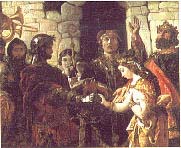
Detail from The marriage of Aífe & Strongbow
as imagined by Daniel Maclise (1806-70)
National Gallery of Ireland
|
As the Anglo-Normans advanced, often with Irish kings as allies, they eventually colonised large areas of Ireland. For protection they built mottes and baileys and castles. They organised manors and founded towns. Ireland was never again to be as Gaelic as it was before they came. They introduced feudalism and English common law, the basis of our present law, to the areas where they ruled. Common law differed in its treatment of women from early Irish laws.
<
When there were no surviving sons, a daughter could inherit her father's estate. When she married, a woman's property passed wholly into the hands of her husband, who became thereafter her sole guardian. Only legitimate children born after marriage could be their father's heirs, and a man could not marry again while his first wife was living. When the husband died, his widow was dowered with a life-interest in one-third of his estate, or if there were no children, she received a half-interest.
Katherine Simms in Women in Irish society, Dublin, 1978, p. 14. |
There were now three systems of law in Ireland: two systems of secular law as well as church law. Each offered advantages and disadvantages depending on the circumstances and people often selected the system most favourable to themselves. For instance, under English common law, men could obtain power and property by marrying heiresses as Strongbow had done in Leinster. Under early Irish or brehon law, both women and men could obtain divorce, though at this time, it was more popular with husbands. Irish women whose husbands divorced them might appeal to church law to have their marriages restored. The history of powerful and wealthy families at this time is very complex and still being researched, while little or nothing is known about the lives of the poor.
Women were sometimes forced into marriages that suited their families.
It took three men to drag Isabella Heron half a mile to the church door, crying and sobbing all the while, after which her father beat her and forced her inside. At the betrothal of Katherine Dowdall, her mother beat her about the head and called her names, while her father drove her into the marriage-bed by threatening to break her bones. Apparently friends and relations stood by and watched on these occasions without interfering, because parents' rights over their daughter were considered absolute. Still more sinister were the rumours that circulated from time to time that some man had beaten his wife to death. Since a husband became his wife's sole guardian, there were no legal steps to be taken in such a situation until it was too late … The church at this period defended women's rights against the inadequacies of secular law, refusing to recognise child marriages … and insisting that no contract was valid unless entered into of free will.
Katherine Simms in Women in Irish society, Dublin, 1978, p. 17. |
The Anglo-Normans employed the native Irish in their manors and, like the Vikings, they traded and intermarried with them. As in time they were becoming 'more Irish than the Irish themselves,' the authorities were displeased as may be seen from the Statute of Kilkenny which demanded:
… that no alliance by marriage, gossipred, fostering of children, concubinage or by amour, nor in any other manner, be henceforth made between the English and Irish … that every Englishman do use the English language, and be named by an English name, leaving off entirely the manner of naming used by the Irish; and that every Englishman use the English custom, fashion, mode of riding and apparel, according to his estate.
Statute of Kilkenny, 1366. |
Powerful families, both colonists and native Irish eventually built stone castles and tower houses, some of which have been restored so as to give an idea of what life was like for the women and men who lived and worked in them in peace and war.
The Normans also built abbeys and churches, having brought their own version of Christianity which they considered superior to that of the native Irish. Figure sculptures on tombs help us to reconstruct how powerful families dressed. Most sculptures represent men garbed as clerics or soldiers but sculptures of women alongide those of their husbands show them wearing long gowns and elaborate hairstyles or head dresses. Both male and female sculptures indicate changing fashions.
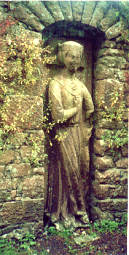
13th century sculpture of a
woman at Cashel
Probably part of a coffin lid originally.
|
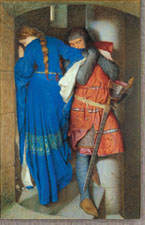
The meeting on the turret stair
as imagined in 1864
by Frederick Burton (1816-1900)
National Gallery of Ireland
|
About a hundred Sheela-na-gig carvings have been found in Ireland, many high up on tower houses, churches and abbeys, mostly in areas where the Anglo-Normans settled. These are rough stone carvings of naked females posed in a manner that displays their sexual organs. Their purpose is uncertain and historians debate their significance. Were they used as lucky charms intended to ward off evil or did they represent some form of misogyny (hatred and contempt for women) at the time? The image of the mermaid with mirror and comb appears to represent female vanity.
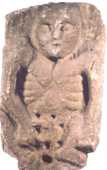
Sheela-na-gig
originally at Seir Kieran, Co. Offaly
National Museum of Ireland
|
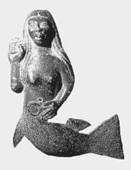
Mermaid
on chancel pillar at Clonfert Cathedral, Co. Galway
|
Alice Kyteler, the subject of a notorious witchcraft trial was a Kilkenny business woman of Flemish descent who married four times and in partnership with the son of her first marriage became very wealthy. The families of her other husbands, together with the bishop of Ossory, accused her of witchcraft in 1324. A complex power struggle ensued between the bishop, the families and various officials. Alice eventually disappeared. Her son William was forced to do penance and make amends but her maid Petronilla de Midia was burnt at the stake as a heretic.
Petronilla de Midia ... was condemned for sorcery, lot taking and offering sacrifice to demons, consigned to the flames and burned. Moreover before her even in olden days it was neither seen nor heard of that anyone suffered the death penalty for heresy in Ireland.
Friar John Clyn, a contemporary chronicler in Kilkenny, quoted by Bernadette Williams, 'The sorcery trial of Alice Kyteler' in History Ireland, Winter 1994, p.24. |
The vast majority of monastic sites in Ireland were foundations for males. However, double monasteries, where males and females lived side by side but separately are also recorded. About a hundred sites in Ireland are associated with convents or nunneries. Some, such as the double monastery under an abbess at Kildare, had been founded in early Christian times. The Anglo-Normans introduced Continental female religious orders such as Augustinians, Arroasian canonesses, Benedictines, Cistercians and Franciscans. Most were suppressed during the Reformation in the sixteenth century.
Questions
- Dervorgilla was the wife of ______ and was abducted by ______ who later married his daughter _____ to his Anglo-Norman ally _______.
- What kind of woman was Dervorgilla, according to Professor F.X. Martin?
- What happened in English common law to a woman's property when she married?
- What did a wife inherit in English common law when her husband died?
- Identify three important differences between early Irish or brehon law and English common law as they affected women.
- Why were women sometimes forced into marriage?
- Identify three reasons which point to a lower status for women at this time.
- Identify three reasons why little is known about the lives of the poor at this time.
Activities
- Discuss the role of women in the Anglo-Norman invasion.
- Role play an interview with Dervorgilla.
- Role play an interview with Aífe in the year 1171.
- Compare the fate of Isabella Heron and Katherine Dowdall above with that of Juliet in Shakespeare's Romeo and Juliet, Act III, Scene V, lines 136-195 and organise a class performance of this short scene.
- Research Alice Kyteler.
- Write a short article urging medieval women to demand improvements in their lives.
- Visit a restored castle or tower house with a view to researching the everyday life of the women who lived and worked there.
- Visit a medieval church, abbey or other site with figure sculptures of women and do a project on them.
- Organise a visit to 'Geraldine Tralee' where the experience of a medieval town has been recreated.
- Research a medieval convent in your area.
- Research medieval women in the local history of your own area.
- Refer to the Irish Annals on the Internet or in book form to research one or more women during the Anglo-Norman period.
- Research the Statute of Kilkenny, 1367




